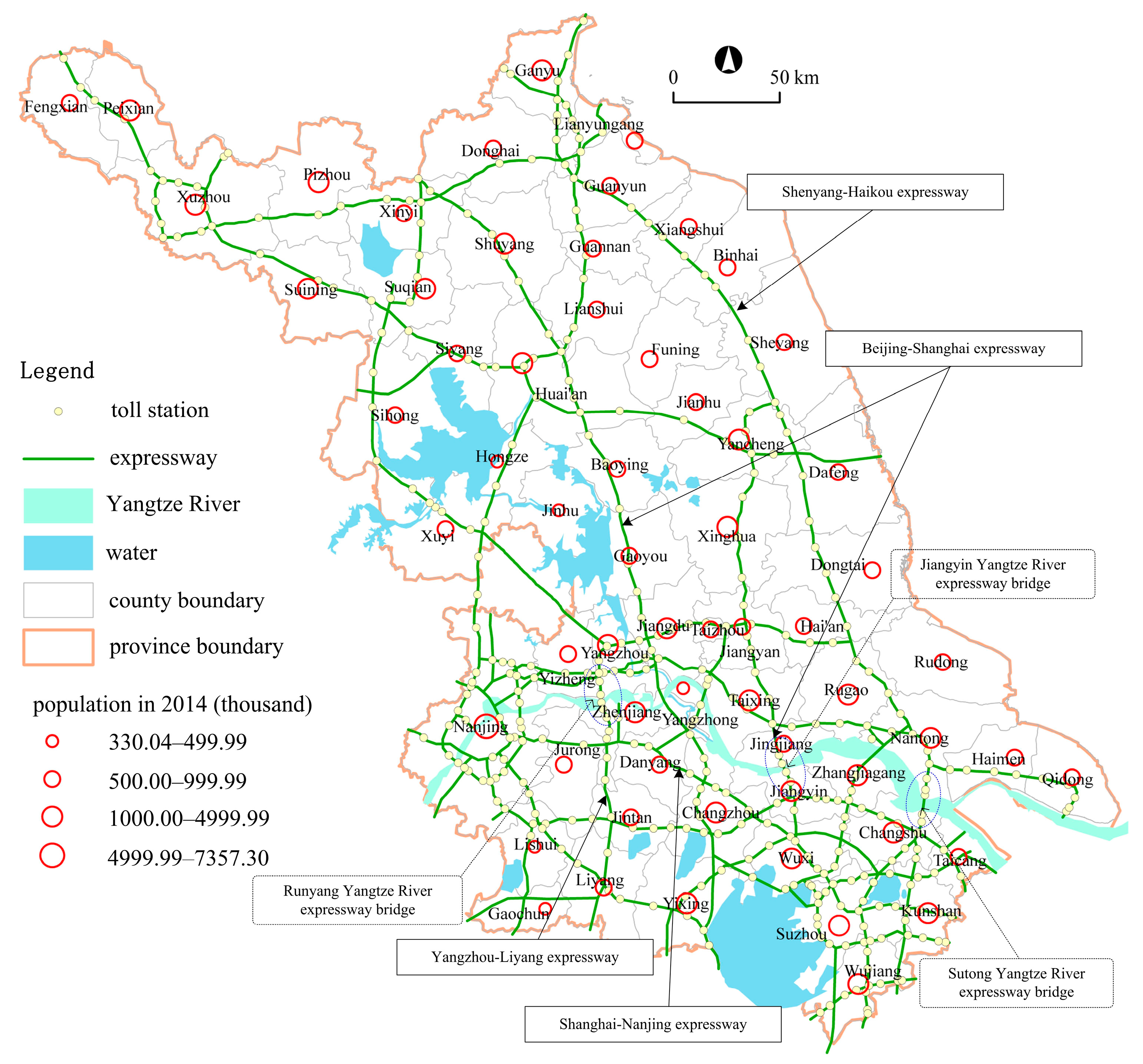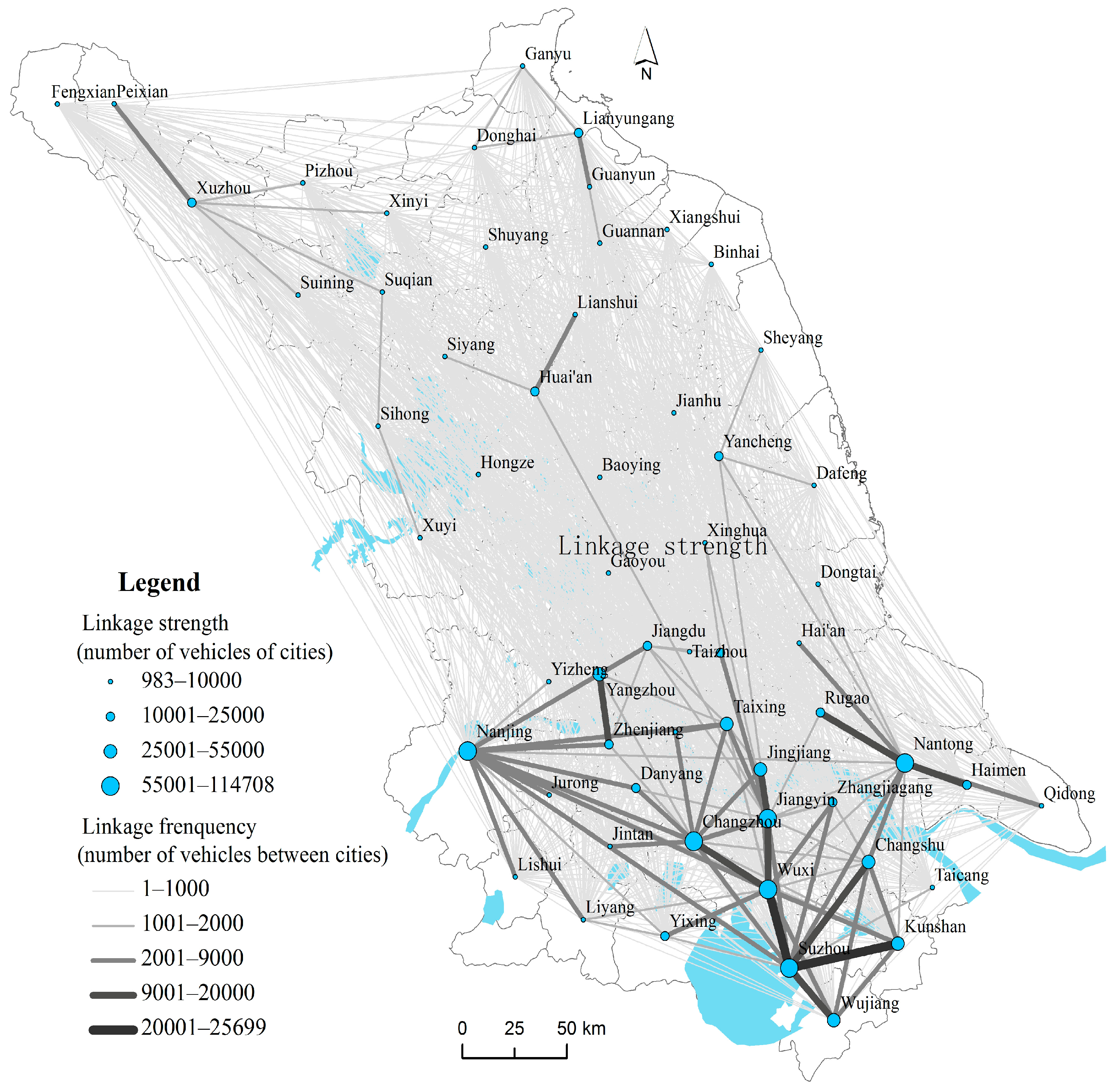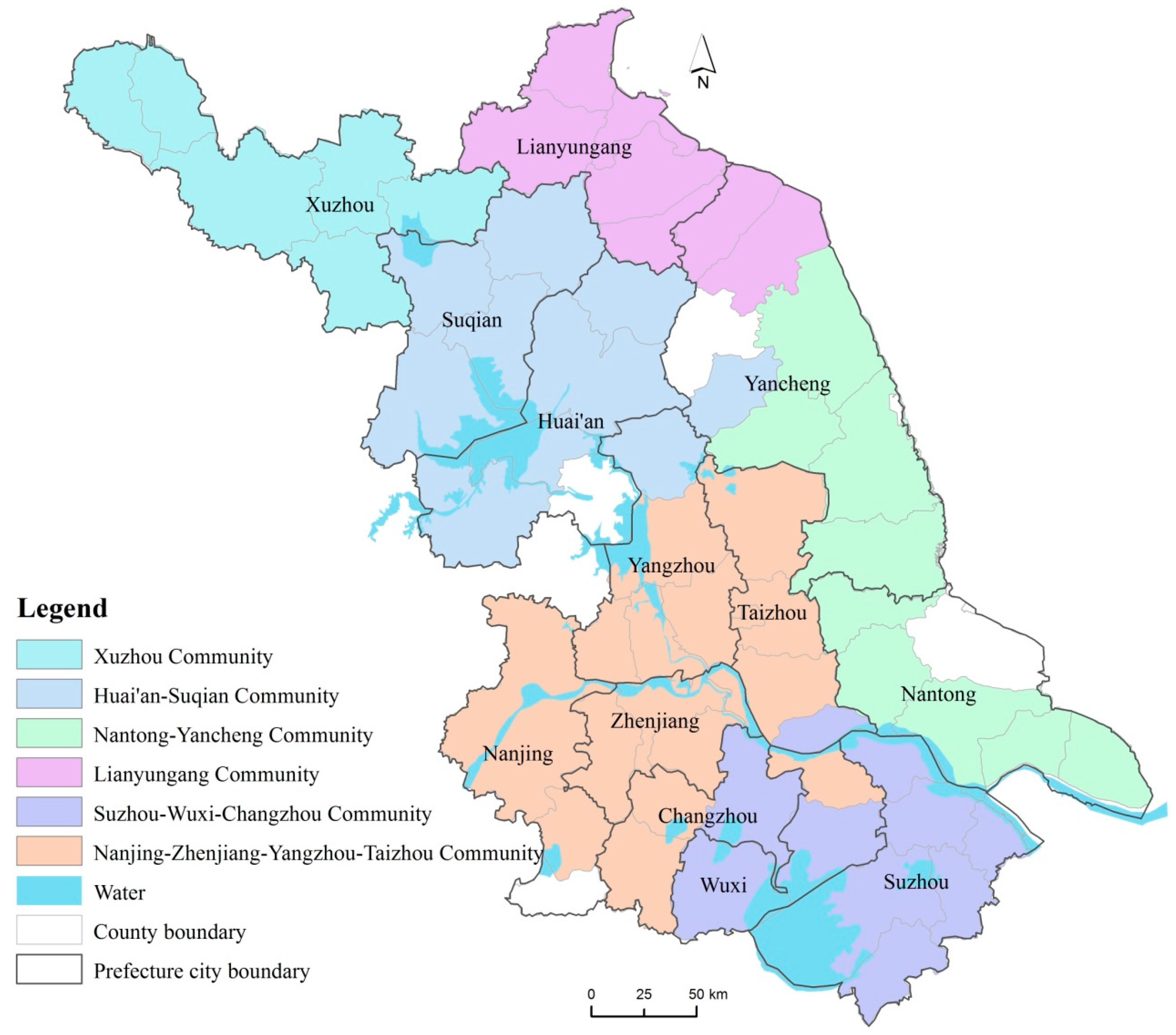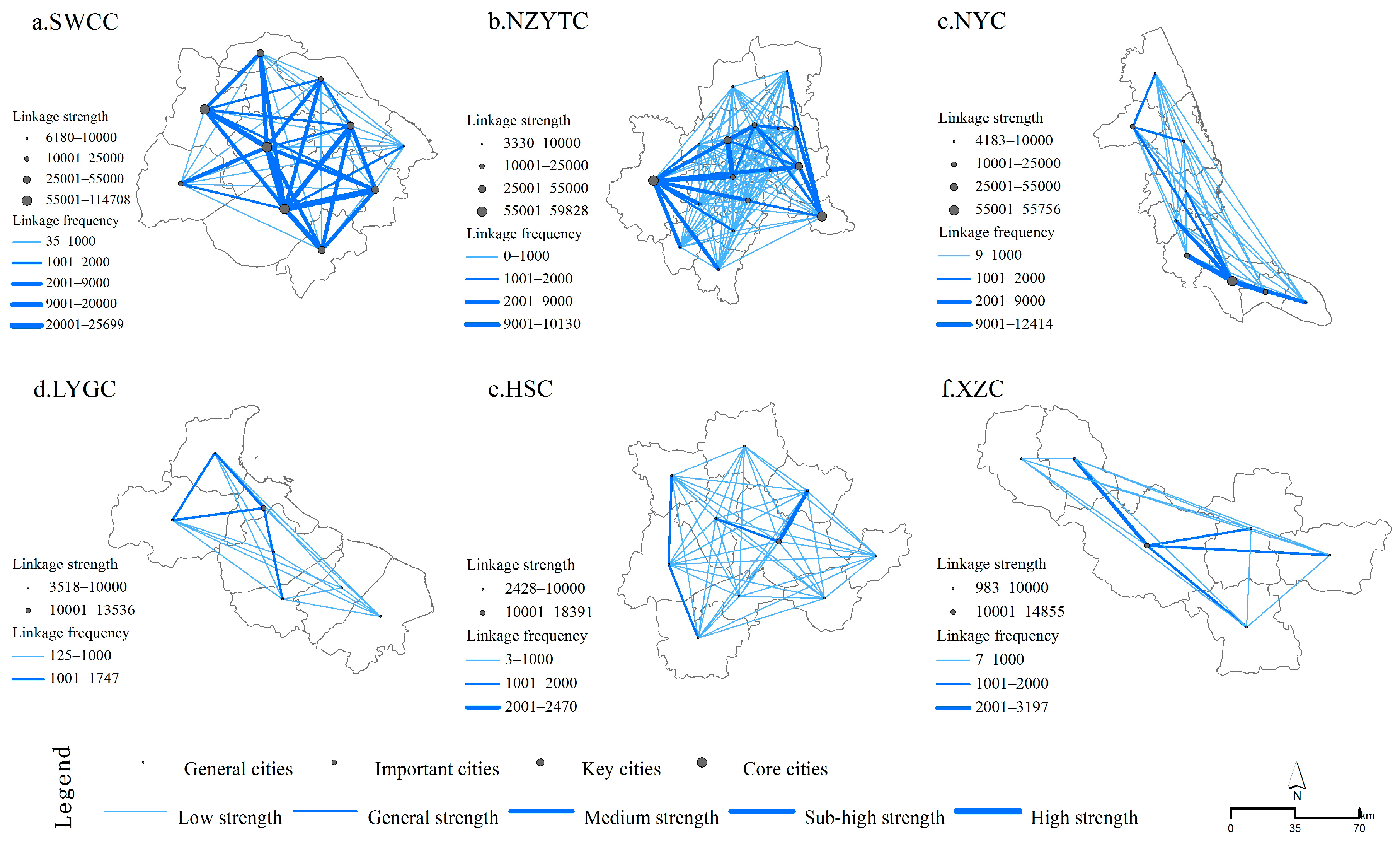Uncovering Spatial Structures of Regional City Networks from Expressway Traffic Flow Data: A Case Study from Jiangsu Province, China
Abstract
:1. Introduction
2. Research Area, Data, and Methods
2.1. Research Area
2.2. Data Source and Processing
2.3. Community Detection
- (1)
- The initial step separates each node into its own community.
- (2)
- The two closest communities are then merged into a new community based on the distance between them.
- (3)
- This procedure is iterated until a single community consisting of all nodes is formed.
- (4)
- The dendrogram is finally formed and the community partition is finished.
3. Macro-Spatial Patterns and Hierarchical Structures of City Networks
3.1. Macro-Spatial Patterns of City Networks
3.2. Hierarchical Structure of Cities
3.3. Hierarchical Structure of Spatial Linkage Frequency
4. Spatial Organizations of City Networks
4.1. Identification of City Communities Based on Network Connection
4.2. Spatial Connection Patterns of City Communities
4.3. Spatial Organization Models of City Communities
5. Conclusions and Outlook
5.1. Conclusions
- (1)
- The macro-spatial patterns of Jiangsu’s city networks, represented by expressway traffic flow, present clear regional differences. The cities with relatively good space connection and network density were distributed along the banks of the Yangtze River, and extended northward to the north boundary of Yangzhou, Taizhou, and Nantong. Furthermore, multiple different sub-network systems were identified as having internal development. Such distribution characteristics show that Jiangsu Province is not a complete economic regional unit. The fracturing of Jiangsu Province is likely due to it belonging to both the Yangtze River Delta Economic Zone, with Shanghai as the core, and the Huaihai Economic Zone, with Xuzhou as the core.
- (2)
- City and city-dyad connection axles have clear hierarchical characteristics. Cities high in the regional hierarchy are relatively economically well-developed and wealthy, and are distributed along the Yangtze River, the provincial boundary, or the trunk expressways. This reflects that the importance of the city hierarchy and it’s spatial coupling with the city’s social economic attributes and geographical locations. This result is similar with Jiao’s study by using the HSR (High-speed rail) lines of Chinese cities in two aspects [13]. One is in statistical, as the relationship between the degree of importance and rank order of cities in terms of centrality conformed to an exponential function [13]. The other is in geographical; the cities with high hierarchical rank were mainly located along trunk expressway lines in this paper, and they were mainly located along trunk HSR lines in Jiao’s study [13]. This signifies that trunk transport lines can gradually outpace or change the hierarchy of cities. According to the city-dyads connection axle, their hierarchy and geographical distance have clear spatial interactions and superposition; the close connection within a short distance is a clear “localization”, or could describe the functional connection inside a relatively complete regional system.
- (3)
- Using community detection to explore city or urban network structures is a new method in city-region analysis [24,38,39]. Six spatially connected and clearly defined “city communities” are identified and four spatial metaphors are found in Jiangsu by using the Walktrap algorithm of community detection in our study, which is similar to Chen’s study by using the Infomap algorithm of community detection for extracting spatial structure and organization patterns of China’s city networks based on the highway passenger flows [39]. From the results, our study suggests that the community detection method would be a powerful analytical tool in the quantitative analysis of multi-scale city networks’ spatial structure.
5.2. Outlook
- (1)
- Currently, the regions with a high degree of network development are mainly concentrated in the Nanjing Metropolis Circle, Suzhou-Wuxi-Changzhou Metropolis Circle, and Nantong Metropolis Circle (including Yancheng), within the scope of the Yangtze River Delta Region. Furthermore, recently, the Nantong Metropolis Circle has undergone swift and violent development. As one of the three metropolis circles that Jiangsu Province is developing, Xuzhou Metropolis Circle is relatively limited in terms of an internal network, and its network intensity is even lower than that of Nantong Metropolis Circle. Therefore, in the future, Xuzhou still needs to build internal strength and functional connections, raise its capability for radiation and agglomeration to surrounding regions, and drive the development of the entire Northern Jiangsu region.
- (2)
- The Urban Axle along East Longhai is an important route of access to the sea in Midwestern China, and acts as an axle belt for driving the development of Northern Jiangsu. However, from existing urban spatial connection patterns, Xuzhou and Lianyungang in the Urban Axle along East Longhai do not show strong functional connection, and their inter-city connection degree is limited. Therefore, in the future, forming the development axle with Xuzhou and Lianyungang as center cities more quickly is necessary. This can be accomplished by relying on traffic corridors such as the Longhai-Lanxin Railway Transportation and Lianyungang-Xuzhou Special Passenger Railway Line.
- (3)
- Historically, Jiangsu Province has lagged in coastal development, and the current development status of coastal cities is not in agreement with the province’s excellent geographical locations. In this context, Jiangsu Province has clearly proposed a development strategy for constructing a coastal urban axle, attempting to facilitate the rapid development of coastal cities and accelerate regional economic integration construction. However, in practice, the spatial connection between NYC and LYGC in coastal areas is weak, and there are opportunities to improve the coastal urban axle.
- (4)
- In comparison with Southern Jiangsu, the hinterland in Northern Jiangsu is still at the preliminary stage of economic development. Furthermore, the difference in development across the region is large, as embodied in the Huai’an and Suqian regions. The HSC has been recognized in previous sections as a low-value region for regional economic development. Therefore, promoting the development of the Huai’an Growth Pole and strengthening the functional connection of HSC with other communities is an important consideration in the future development of Jiangsu Province. This would facilitate significant regional development and change the current state of diffused urban space organization and imbalanced regional development in Jiangsu Province.
Acknowledgments
Author Contributions
Conflicts of Interest
References
- Castells, M. Globalisation, networking, urbanisation: Reflections on the spatial dynamics of the information age. Urban Stud. 2010, 47, 2737–2745. [Google Scholar] [CrossRef]
- Castells, M. The Rise of the Network Society; Blackwell: Oxford, UK, 1996; pp. 132–134. [Google Scholar]
- Batty, M. Urban Information Networks: The Evolution and Planning of Computer Communications Infrastructure. In Cities of the 21st Century New Technologies and Spatial System; Brotchie, J., Batty, M., Hall, P., Eds.; Longman Cheshire: Boulder, CO, USA, 1991; pp. 65–72. [Google Scholar]
- Taylor, P. Urban hinterworlds: Geographies of corporate service provision under conditions of contemporary globalization. Geography 2001, 86, 51–60. [Google Scholar]
- Taylor, P.; Hoyler, M.; Verbruggen, R. External urban relational process: Introducing central flow theory to complement central place theory. Urban Stud. 2010, 47, 2803–2818. [Google Scholar] [CrossRef] [Green Version]
- Taylor, P.; Catalano, G.; Walker, D.R.F. Measurement of the world city network. Urban Stud. 2002, 39, 2367–2376. [Google Scholar] [CrossRef]
- Taylor, P. Specification of the world city network. Geogr. Anal. 2001, 33, 181–194. [Google Scholar] [CrossRef]
- Camagni, R.; Salone, C. Network Urban Structures in Northern Italy: Elements for a Theoretical Framework. Urban Stud. 1993, 30, 1053–1064. [Google Scholar] [CrossRef]
- Scott, A.J.; Agnew, J.; Soja, E.W. Global City-Regions: Trends, Theory, Policy; Oxford University Press: Oxford, UK, 2001; pp. 326–327. [Google Scholar]
- Hall, P. Planning for the mega-city: A new eastern Asian urban form? In East West Perspectives on 21st Century Urban Development: Sustainable Eastern and Western Cities in the New Millennium; Brotchie, J., Newton, P., Hall, P., Eds.; Ashgate: Aldershot, UK, 1999; pp. 3–36. [Google Scholar]
- Hall, P.; Pain, K. The Polycentric Metropolis: Learning from Mega-City Regions in Europe; Taylor & Francis Group: Routledge, UK, 2006; pp. 384–385. [Google Scholar]
- Derudder, B.; Witlox, F. Mapping world city networks through airline flows: Context, relevance, and problems. J. Transp. Geogr. 2008, 16, 305–312. [Google Scholar] [CrossRef]
- Jiao, J.; Wang, J.; Jin, F. Impacts of high-speed rail lines on the city network in China. J. Transp. Geogr. 2017, 60, 257–266. [Google Scholar] [CrossRef]
- Limtanakool, N.; Schwanen, T.; Dijst, M. Developments in the Dutch urban system on the basis of flows. Reg. Stud. 2009, 43, 179–196. [Google Scholar] [CrossRef]
- Li, J.; Ye, Q.; Deng, X.; Liu, Y.; Liu, Y. Spatial-temporal analysis on Spring Festival travel rush in China based on multisource big data. Sustainability 2016, 8, 1184. [Google Scholar] [CrossRef]
- Malecki, E.J. The economic geography of the Internet’s infrastructure. Econ. Geogr. 2002, 78, 399–424. [Google Scholar] [CrossRef]
- Mitchelson, R.L.; Wheeler, J.O. The flow of information in a global economy: The role of the American urban system in 1990. Ann. Assoc. Am. Geogr. 1994, 84, 87–107. [Google Scholar] [CrossRef]
- Chen, W.; Xiu, C.L.; Liu, W.D.; Yu, Z.Y. Featured graphic. Visualizing intercity scientific collaboration networks in China. Environ. Plan. A 2015, 47, 1–3. [Google Scholar] [CrossRef]
- Taylor, P. The new geography of global civil society: NGOs in the world city network. Globalizations 2004, 1, 265–277. [Google Scholar] [CrossRef]
- Gutierrez, J.; Gonzalez, R.; Gomez, G. The European high speed train network: Predicted effects on accessibility patterns. J. Transp. Geogr. 1996, 4, 227–238. [Google Scholar] [CrossRef]
- Li, S.M.; Shum, Y.M. Impacts of the national trunk highway system on accessibility in China. J. Transp. Geogr. 2001, 9, 39–48. [Google Scholar] [CrossRef]
- Amaral, L.A.N.; Scala, A.; Barthélémy, M. Classes of small-world networks. Proc. Natl. Acad. Sci. USA 2000, 97, 11149–11152. [Google Scholar] [CrossRef] [PubMed]
- Bagler, G. Analysis of the airport network of India as a complex weighted network. Physica A 2008, 387, 2972–2980. [Google Scholar] [CrossRef]
- Zhou, M.; Yue, Y.; Li, Q.Q. Portraying temporal dynamics of urban spatial divisions with mobile phone positioning data: A complex network approach. Int. J. Geo-Inf. 2016, 5, 1–21. [Google Scholar] [CrossRef]
- Dash, N.G.; Rae, A. An economic geography of the United States: From commutes to megaregions. PLoS ONE 2016, 11, e0166083. [Google Scholar]
- Beaverstock, J.V.; Smith, R.G.; Taylor, P. World-city network: A new metageography? Ann. Assoc. Am. Geogr. 2000, 90, 123–134. [Google Scholar] [CrossRef]
- Girvan, M.; Newman, M.E.J. Community structure in social and biological networks. Proc. Natl. Acad. Sci. USA 2002, 99, 7821–7826. [Google Scholar] [CrossRef] [PubMed]
- Clauset, A.; Newman, M.E.J.; Moore, C. Finding community structure in very large networks. Phys. Rev. E 2004, 70, 066111. [Google Scholar] [CrossRef] [PubMed]
- Pons, P.; Latapy, M. Computing communities in large networks using random walks. J. Graph Algorithms Appl. 2006, 10, 191–218. [Google Scholar] [CrossRef]
- Blondel, V.D.; Guillaume, J.L.; Lambiotte, R. Fast unfolding of communities in large networks. J. Stat. Mech. 2008, 2008, P10008. [Google Scholar] [CrossRef]
- Raghavan, U.N.; Albert, R.; Kumara, S. Near linear time algorithm to detect community structures in large-scale networks. Phys. Rev. E 2007, 76, 036106. [Google Scholar] [CrossRef] [PubMed]
- Rosvall, M.; Bergstrom, C.T. Maps of random walks on complex networks reveal community structure. Proc. Natl. Acad. Sci. USA 2008, 105, 1118–1123. [Google Scholar] [CrossRef] [PubMed]
- Steinhaeuser, K.; Chawla, N.V. Identifying and evaluating community structure in complex networks. Pattern Recognit. Lett. 2010, 31, 413–421. [Google Scholar] [CrossRef]
- Yang, Z.; Algesheimer, R.; Tessone, C.J. A comparative analysis of community detection algorithms on artificial networks. Sci. Rep. 2016, 6, 30750. [Google Scholar] [CrossRef] [PubMed]
- Zipf, G.K. Human Behavior and the Principle of Least Effort; Addison-Wesley: Cambridge, UK, 1949; p. 69. [Google Scholar]
- Kanungo, T.; Mount, D.; Netanyahu, N.; Piatko, C. An efficient K-means clustering algorithm: Analysis and implementation. IEEE Trans. Pattern Anal. Mach. Intell. 2000, 24, 881–892. [Google Scholar] [CrossRef]
- Christaller, W. Die Zentralen Orte in Süddeutschland; Gustav Fischer Verlag: Jena, German, 1933; pp. 68–124. [Google Scholar]
- Jiao, J.J.; Wang, J.E.; Jin, F.J.; Wang, H. Impact of high-speed rail on inter-city network based on the passenger train network in China, 2003–2013. Acta Geogr. Sin. 2016, 71, 265–280. (In Chinese) [Google Scholar]
- Chen, W.; Liu, W.D.; Ke, W.Q.; Wang, N.Y. The spatial structure and organization patterns of China’s city networks based on the highway passenger flows. Acta Geogr. Sin. 2017, 72, 224–241. (In Chinese) [Google Scholar]






| Hierarchy | Linkage Strength | Cities and Number in Hierarchical Class ( ) |
|---|---|---|
| Core cities | >55,000 | Suzhou, Wuxi, Nanjing, Jiangyin, Nantong, and Changzhou (6 cities) |
| Key cities | 25,000–55,000 | Kunshan, Changshu, Jingjiang, Yangzhou, Taixing, and Wujiang (6 cities) |
| Important cities | 10,000–25,000 | Zhenjiang, Rugao, Jiangdu, Huai’an, Zhangjiagang, Xuzhou, Yancheng, Yixing, Haimen, Lianyungang, Jiangyan, and Danyang (12 cities) |
| General cities | <10,000 | Liyang, Hai’an, Guanyun, Yangzhong, Suqian, Jurong, Jintan, and others (35 cities) |
| Hierarchy | Linkage Frequency | City-Dyads and Number in Hierarchical Class ( ) |
|---|---|---|
| High | >20,000 | Suzhou-Wuxi and Suzhou-Kunshan (2 city-dyad) |
| Sub-high | 9000–20,000 | Suzhou-Changshu, Suzhou-Wujiang, Jiangyin-Jingjiang, Nantong-Rugao, Yangzhou-Zhenjiang, Nantong-Haimen, Wuxi-Changzhou, Wuxi-Jiangyin, and others (8 city-dyad) |
| Medium | 2000–9000 | Wuxi-Jingjiang, Nanjing-Changzhou, Nantong-Changshu, Wuxi-Yixing, Suzhou-Changzhou, Jiangyin-Taixing, Yangzhou-Jiangdu, and others (39 city-dyad) |
| General | 1000–2000 | Nanjing-Yixing, Jiangdu-Taixing, Wuxi-Changshu, Changzhou-Zhangjiagang, Suqian-Sihong, Xuzhou-Suining, Xuzhou-Pizhou, Lianyungang-Guannan, Yangzhou-Changzhou, and others (53 city-dyad) |
| Low | 1–1000 | Nantong-Taixing, Haimen-Qidong, Huai’an-Suqian, Huaian-Hongze, Zhangjiagang-Jingjiang, Wuxi-Danyang, and others (1571 city-dyad) |
| Community | Inner Strength | Proportion of All Community Strength (%) | Proportion of All Community Inner Strength (%) |
|---|---|---|---|
| Jiangsu province | 509,142 | 100 | - |
| All communities inner strength | 320,534 | 62.96 | 100 |
| XZC | 9712 | 1.91 | 3.03 |
| HSC | 14,520 | 2.85 | 4.53 |
| LYGC | 15,783 | 3.10 | 4.92 |
| NYC | 39,571 | 7.77 | 12.35 |
| NZYTC | 87,707 | 17.23 | 27.36 |
| SWCC | 153,241 | 30.10 | 47.81 |
© 2017 by the authors. Licensee MDPI, Basel, Switzerland. This article is an open access article distributed under the terms and conditions of the Creative Commons Attribution (CC BY) license (http://creativecommons.org/licenses/by/4.0/).
Share and Cite
Ke, W.; Chen, W.; Yu, Z. Uncovering Spatial Structures of Regional City Networks from Expressway Traffic Flow Data: A Case Study from Jiangsu Province, China. Sustainability 2017, 9, 1541. https://doi.org/10.3390/su9091541
Ke W, Chen W, Yu Z. Uncovering Spatial Structures of Regional City Networks from Expressway Traffic Flow Data: A Case Study from Jiangsu Province, China. Sustainability. 2017; 9(9):1541. https://doi.org/10.3390/su9091541
Chicago/Turabian StyleKe, Wenqian, Wei Chen, and Zhaoyuan Yu. 2017. "Uncovering Spatial Structures of Regional City Networks from Expressway Traffic Flow Data: A Case Study from Jiangsu Province, China" Sustainability 9, no. 9: 1541. https://doi.org/10.3390/su9091541





